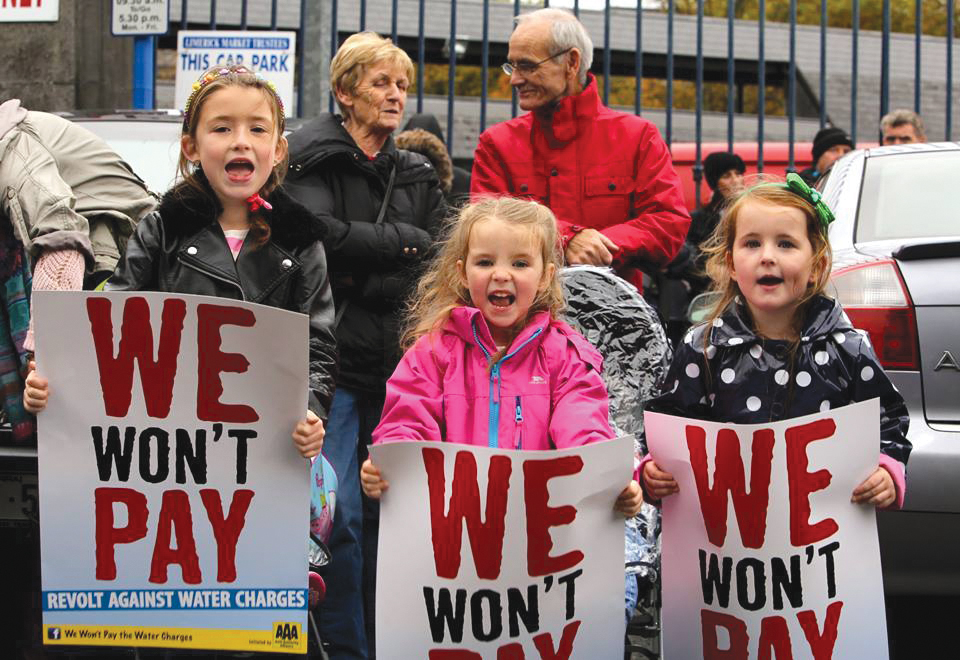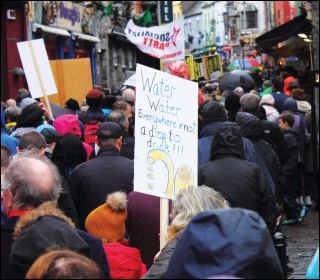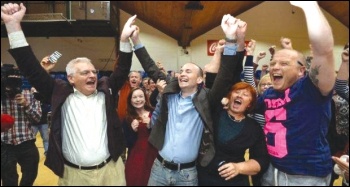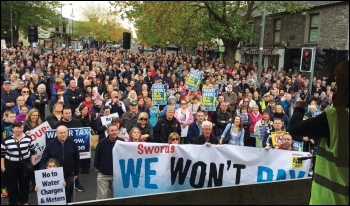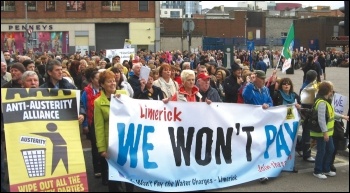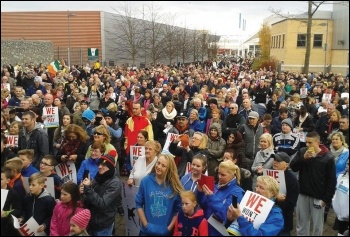The growing movement against water tax and austerity
Kevin McLoughlin, Socialist Party (CWI Ireland)
11 October 2014 saw the opening of a whole new chapter in the struggle of the working class in Ireland. Discontent hit the streets of Dublin in a 100,000-strong demonstration against the new water tax and austerity.
On the same day, the same wave of anger catapulted Anti Austerity Alliance (AAA) candidate Paul Murphy to victory in the Dublin South West byelection, defeating a stunned Sinn Fein along the way.
Paul has been elected as an AAA TD (MP) to the Dáil (Irish Parliament), joining fellow Socialist Party members Joe Higgins, who was elected in the 2011 general election, and Ruth Coppinger, who won the Dublin West byelection in May this year. Paul’s campaign made the water tax the main issue in the election.
Water charges – until now covered through other existing taxes – will cost many more than €500 a year. Bills were due to arrive in January 2015 but the actual billing period started from 1 October. Irish Water, the new company established to oversee the charge, had begun sending out ‘information’ packs to each household in the country.
1 November saw further demonstrations against water charges in 93 towns and cities across the country and this time 150,000 turned out on a day of torrential rain. The byelection and these demonstrations together have given many people new confidence that now, after six years of austerity, there is a chance to build a new fighting movement for working class people.
One year’s difference
This is in stark contrast to the mood last year. Ironically, essential to this change was the extensive propaganda that Ireland is experiencing an economic recovery.
The heads of many people lifted as the talk of endless crisis was replaced with the prospect of an economic improvement. When the “recovery” turned out to be a recovery for the rich and austerity continued, particularly in the form of the new water charges, people proved more open, angry and impatient than before.
The change has gripped the most disadvantaged sections of the working class especially, alongside an understandable anti-party sentiment because of the role of Labour in particular.
The changed situation was reflected in the local and European elections in May when AAA, which the Socialist Party is part of, got 14 councillors elected in Dublin, Cork and Limerick. Some other lefts and “independents” (reflecting the disgust at the political establishment) also did well. The main gains however, were made by Sinn Fein who went from 54 councillors to 159, and no MEPs to three of Ireland’s eleven.
Sinn Fein got over 15% of the vote in the locals and close to 20% in the Euro elections. With the unpopularity of the government, this put it in pole position to become the biggest party with the prospect of being in the next government.
On 9 October, the day before the Dublin South West byelection, a new opinion poll indicated that Sinn Fein had increased its national support by 4%, up to 24%.
The growth of Sinn Fein, as well as the vote it received in the Dublin South West area in May’s elections, caused all commentators to predict a Sinn Fein victory. Paddy Power bookmakers had Sinn Fein candidate Cathal King as the 1/25 odds-on favourite to win.
Positive message
But our positive message that people could refuse to pay and could defeat water charges exposed Sinn Fein’s utter cynicism.
Sinn Fein said that non-payment will mean people build up huge debts that they will inevitably have to pay and that people will also get hefty financial penalties. They were trying to instil fear and demoralisation as a means to win the election.
Two days before the election, news filtered through that Sinn Fein leaders Gerry Adams and Mary Lou McDonald had, when responding to a press conference question, admitted they would pay their water charges. This was not prominently featured in most of the mainstream media – but we made sure many voters knew about it!
After the first count Sinn Fein had 7,288 votes (30%) and the AAA were 748 votes behind on 6,540 (27%). However when the other candidates were progressively eliminated, the AAA got an additional 3,025 transfer votes while Sinn Fein got just 1,711, meaning Paul Murphy and the AAA won by 566 votes.
In May in these areas Sinn Fein got 9,737 first preference votes, so they were down 2,449 votes in October’s election. In May the AAA got 3,537, so actually increased its vote by an incredible 3,003 votes, an 85% increase on a significantly lower turnout compared to the local elections.
It wasn’t only Sinn Fein who was stunned, so too was the political establishment, the media and probably many on the left. Immediately the government brought in minor concessions on the water charges, but this has only emboldened the view that they must be scrapped altogether.
This byelection was the most dramatic illustration yet of the decisive shift that is taking place away from the parties of the capitalist establishment – Fine Gael, Labour and Fianna Fail. Their combined vote was just 26% – less than Paul Murphy on his own.
On the march
The demonstration of 100,000 on 11 October had a very working class composition. But most importantly it was a mass mobilisation from below – a DIY or self-mobilisation of the working class.
This reflected the anger at and intense activity against the installation of water meters by Irish Water that have engulfed many working class communities, particularly in Dublin, in recent months.
The demonstration was called under the umbrella banner of Right2Water, which was initiated earlier this year by People Before Profit Alliance (PBPA) and a couple of unions (the AAA and Socialist Party are part of Right2Water).
But it was clear for some weeks beforehand that ordinary people themselves has seized that date and were mobilising to make a stand against water charges and austerity.
The original plan was to have a demonstration in September, but the Socialist Party argued within Right2Water that it should be in October, closer to Budget Day, 14 October.
Trade union leaders
Its significance is re-enforced when compared to the last demonstration organised by the Irish Congress of Trade Unions on 9 October 2013.
In total ICTU mobilised 60,000 around the country that day and certainly no more than 40,000 people in Dublin itself; most of them left disgusted when ICTU leaders failed to put forward plans for real action against austerity.
But by 11 October, working class people had cut through the demoralising fog created by ICTU’s ongoing sell-out of the last six years, and organised their own mass mobilisation.
A number of years ago, residents of Ballyhea, a small village in County Cork, began holding a protest march every Sunday through the main street against the bailouts of the banks and austerity under the banner “Ballyhea Says No”.
The idea of “Says No” entered the popular psyche and now in parts of the cities, groups of ordinary people have come together and in quite a number of cases have put the name of the area before “Says No”, or used some other similar name.
The installation of water meters was the catalyst that caused many of these groups to emerge. Local Facebook pages have sprung up, warning where water meter installations are taking place and mobilising people to protest.
There have also been some serious skirmishes with the police in a number of areas, particularly in parts of Dublin, but also in Cork.
Disgracefully the police have been mobilised to assist Irish Water to impose its metering policy. Many have been arrested but no one has been sent to prison, so far.
Street meetings
Street meetings have emerged as a simple and very quick way of pulling the community together against the water charges. By word of mouth or simple flyers, people are meeting, often at the green patches in estates or communities.
One part of north east Dublin has seen more than ten “Says No” type groups being established with thousands attending street meetings. These developments fed into the mass mobilisation on 11 October.
Two weeks later and given the size of the city, equally as impressive as 11 October, was the 10,000 that marched through the streets of Limerick led by We Won’t Pay, the non-payment campaign initiated by the AAA. Very big demonstrations continued in many areas, culminating in the national day of action on 1 November.
The strong sentiment on these demonstrations and among the working class generally, particularly those under fifty, is not to pay the water charges. However, while Right2Water put out the date for what became a mass demonstration, it makes a virtue out of not advocating mass non-payment.
From the start Right2Water pointed people towards a more conservative campaign of political pressure on the parties and not towards an active campaign to build mass non-payment. Because of this there is a serious question mark over whether it can play a positive role or will cause confusion.
Right2Water is now being used by some, including Sinn Fein and some unions, as a cloak to hide their refusal to actually fight against water charges. The more the Dublin South West byelection has exposed Sinn Fein’s real position, the more it tries to wear the Right2Water banner.
Lead the battle
Unfortunately there is a prevarication by some, such as PBPA and some left TDs on the issue of non-payment, creating a danger for the new movement. While there is huge hatred and anger at the water charges, significant layers, particularly of older people are still fearful and not confident about non-payment.
A recent opinion poll indicated that only two-fifths – 41% – would pay the water charges, 25% wouldn’t, 18% said ‘it depends’ and the charges weren’t applicable to the other 8%.
In this situation, lefts and socialists should be leading the battle and giving people the confidence to add mass non-payment to the mass mobilisations. They should explain that water charges can’t be deducted from people’s income, that people’s water can’t be disconnected anymore and that this weakened government can be decisively knocked back by mass non-payment and an active struggle.
Instead non-payment is sometimes mentioned in the odd speech or in the small print in a leaflet, with a refusal to advocate mass non-payment as the essential and central tactic to defeat the water tax.
11 October and 1 November represent the emergence of a new working class movement, beginning in the communities. But whether this movement can win depends on the development of a fighting leadership that gives people confidence to say ‘we won’t pay’.
Sinn Fein: not a left alternative
Sinn Fein is not a party of the left and its rise will result in a similar situation as with Irish Labour: wasted hopes and disappointment. Unfortunately some, including the People Before Profit Alliance and the Socialist Workers Party, refer to Sinn Fein as ‘left’, and imply that it has something to offer the working class. If the AAA had adopted a similar approach in the Dublin South West byelection, Sinn Fein would have romped home.
The water charges clearly show that sell-out is inherent in Sinn Fein’s approach. It wanted to use water charges as a bargaining chip in the formation of the next government, that’s why it refused to say water charges were a redline issue. That means either it would keep water charges if in government or, if it did abolish them, would accept other austerity measures instead.
Sinn Fein is preparing to manage austerity in the south, as it has done in the north, because it works within the confines of the capitalist system.
If the left, new activists and groups that are emerging came together and advocated the programme below and took up Sinn Fein in a firm way, a strong and principled working class left alternative could emerge out of the next general election, just over a year away:
- Mass non-payment of water charges
- Scrap all the new taxes and charges
- No more austerity
- No support for coalition government with capitalist establishment parties
- Put need before greed – for democratic public ownership of the key sectors of the economy
That could be the real opposition to the next capitalist government, whether it includes Sinn Fein or not, and could put a genuine fight for socialist change on the agenda in the years ahead.
- A poll published on 2 November showed a collapse in support for the Fine Gael and Labour government coalition. Sinn Fein is now the most popular party, but almost half polled want a new political party.


